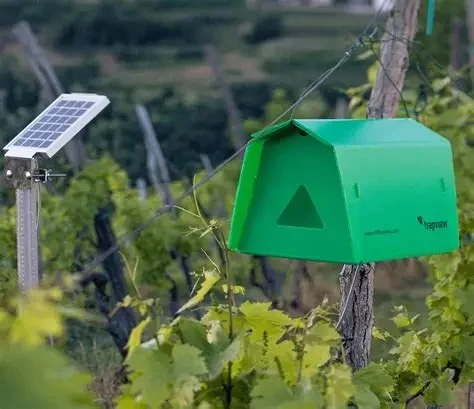
How to Use Smart Devices to Track Pest Locations
- 1- Understanding Smart Devices for Pest Control
- 2- How Smart Devices Help Track Pest Locations
- 3- Types of Smart Devices for Pest Detection
- 4- Steps to Use Smart Devices for Pest Control
- 5- Real-Life Example: Smart Devices in Pest Control
1. Understanding Smart Devices for Pest Control
In today’s digital age, technology has made significant advancements in many fields, and pest control is no exception. Smart devices designed for pest detection are now available, providing homeowners with an efficient, non-invasive way to track and manage pest problems. These devices use sensors, wireless technology, and advanced algorithms to detect and locate pests such as rodents, termites, or insects in real time.By integrating smart technology into pest control, you can stay one step ahead of pests and avoid the damage they might cause. Rather than relying solely on traditional methods like traps or sprays, smart devices allow for more precise monitoring, potentially saving both time and money in the long run.At PestControlHub, we offer a wide selection of smart pest control devices tailored to meet your needs, helping you make informed decisions based on the most current technology in the market.2. How Smart Devices Help Track Pest Locations
Smart devices for pest control work by continuously monitoring areas prone to pest activity. These devices are equipped with sensors that detect specific movements, sounds, or heat patterns associated with pest behavior. Once a pest is detected, the device sends a notification to your smartphone, alerting you to the exact location.One of the significant advantages of using smart devices is that they provide real-time updates, allowing for quick and precise action. This proactive approach helps in preventing pest infestations from spreading. Additionally, by having access to the device’s data and notifications, you can track pest patterns over time and make more informed decisions regarding pest management strategies.Many smart pest control devices are also designed to be easy to install and use, often requiring only a smartphone app for full control and monitoring.3. Types of Smart Devices for Pest Detection
There are various types of smart devices available to help with pest control. Each device is designed for a specific purpose, ensuring that you can find the most suitable option for your pest problem.- Smart Traps: These devices are designed to detect and capture pests like rodents or insects. They often use sensors to notify you when the trap has been triggered, saving you the trouble of checking manually.
- Motion-Sensing Devices: Motion sensors can detect movement in areas where pests are likely to be active. These devices send instant alerts, allowing for immediate action to be taken.
- Smart Sensors for Termites: For homeowners concerned about termites, these specialized sensors detect vibrations and sounds associated with termite activity, enabling early detection of potential damage.
- Insect-Tracking Devices: Insects like ants or cockroaches are difficult to spot with the naked eye. These devices track their movement patterns, helping to locate their nests and assess the severity of the infestation.
4. Steps to Use Smart Devices for Pest Control
Using smart devices to track and control pests is relatively simple. Here’s a step-by-step guide on how to incorporate them into your pest control strategy:- Step 1 – Choose the Right Device: Select a smart device that is tailored to the pests you are trying to manage. For example, choose a motion-sensing device for rodents or an insect tracker for ants.
- Step 2 – Install the Device: Most smart devices are easy to set up. Follow the manufacturer’s instructions, and ensure the device is placed in areas with high pest activity.
- Step 3 – Connect to Your Smartphone: Once installed, connect the device to your smartphone using its dedicated app. This will allow you to receive real-time notifications and monitor the device’s data remotely.
- Step 4 – Monitor and Act: Regularly check the app for updates and notifications. Once a pest is detected, take the necessary steps, such as setting a trap, sealing entry points, or calling a pest control professional.
- Step 5 – Review Data and Adjust: Over time, analyze the data from your smart device. You may discover patterns of pest activity, allowing you to adjust your pest control strategy accordingly.







 Wildlife Resolutions4.0 (443 reviews)
Wildlife Resolutions4.0 (443 reviews) Pest Marshals of Toledo5.0 (2 reviews)
Pest Marshals of Toledo5.0 (2 reviews) LS Rodent Proofing & Pest Control Service5.0 (4 reviews)
LS Rodent Proofing & Pest Control Service5.0 (4 reviews) Best Termite & Pest Control4.0 (16 reviews)
Best Termite & Pest Control4.0 (16 reviews) Varment Guard Wildlife Services5.0 (28 reviews)
Varment Guard Wildlife Services5.0 (28 reviews) Pestban Inc4.0 (394 reviews)
Pestban Inc4.0 (394 reviews) How to Use Monitors to Detect Pest Entry: A Comprehensive Guide
How to Use Monitors to Detect Pest Entry: A Comprehensive Guide How to Predict Which Pests Will Invade Next – Smart Pest Forecasting for the U.S.
How to Predict Which Pests Will Invade Next – Smart Pest Forecasting for the U.S. How to Conduct a Pest Risk Assessment at Home – Expert Guide
How to Conduct a Pest Risk Assessment at Home – Expert Guide How to Block Pest Entry Around Deck Joists: Effective Solutions
How to Block Pest Entry Around Deck Joists: Effective Solutions How to Safely Use Fumigation Methods: A Comprehensive Guide for Homeowners
How to Safely Use Fumigation Methods: A Comprehensive Guide for Homeowners Why Pests Are More Active After Rain: Understanding the Link Between Weather and Pest Behavior
Why Pests Are More Active After Rain: Understanding the Link Between Weather and Pest Behavior